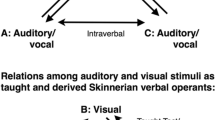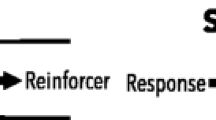Abstract
The acquisition of verbal behavior is complex and requires the analysis of myriad variables. Ernst Moerk estimated that by the time a child has reached 4 years of age they have experienced nearly 9 million language learning trials with mothers using at least 14 categories of maternal teaching interactions. The interactions provide a foundation for children learning the tact, mand, echoic, intraverbal, autoclitic, and other relations, described by Skinner in Verbal Behavior. Here we examine two relations that have been overlooked to some extent and arguably account for many of the generative features of verbal behavior and shared meaning: the abstract tact, or more precisely the interdimensional abstract tact, and the autoclitic frame. We describe Goldiamond’s treatment of stimulus control in its many forms; dimensional, abstractional, and instructional, and how it can be used to understand the acquisition of both intradimensional and interdimensional abstract tacts and autoclitic frames that guide seemingly complex relational responding and meet consequential contingency requirements. We argue the development of complex relational responding in children can be explained parsimoniously without mediating variables or hypothetical constructs.




Similar content being viewed by others
Data Availability
Data sharing not applicable to this article as no datasets were generated or analyzed during the current study.
Notes
Layng (2019) provides an example of such a program used to teach the abstract tacts solid, liquid, and gas and their corresponding molecular movements.
This observation was first made by James G. Holland (J. G. Holland, personal communication, May, 1986).
The discussion has focused on what may be considered conjunctive relations. These may be considered “and” relations in as much as responding to a set or features is required. That is, property 1 and property 2 and property 3, control responding, for example. The absence of any of the properties results in a nonexample. It is important to note, however, that there are other relations that can also acquire stimulus control over behavior. This class is defined by features not necessarily shared by all class members. These relations are what Bruner al. (1956) called disjunctive concepts.
Cohen makes the case that the entire treatment of “perspective taking” can be explained best as a function of the same relations found in metaphor. It makes for a fascinating read.
Other behavioral processes likely contribute to some of the punctuations or “leaps” observed in verbal behavior performance. Two such processes in particular may play a significant role, the first is contingency adduction, the recruitment and often combinations of new patterns from previously established components (see Andronis et al., 1997; Johnson & Layng, 1992; Layng et al., 2004), and the second is the effect of verbal behavioral cusps, where certain behavior patterns are established that bring the child into contact with contingencies not previously available (see Rosales-Ruiz & Baer, 1997).
References
Andronis, P. T., Layng, T. V., & Goldiamond, I. (1997). Contingency adduction of “symbolic aggression” by pigeons. Analysis of Verbal Behavior, 14(1), 5–17. https://doi.org/10.1007/BF03392913
Barnes-Holmes, D., Barnes-Holmes, Y., & Cullinan, V. (2000). Relational frame theory and Skinner’s verbal behavior: A possible synthesis. The Behavior Analyst, 23, 69–84. https://doi.org/10.1007/BF03392000
Barnes-Holmes, D., Finn, M., McEnteggart, C., & Barnes-Holmes, Y. (2018). Derived stimulus relations and their role in a behavior-analytic account of human language and cognition. Perspectives on Behavior Science, 41, 155–173. https://doi.org/10.1007/s40614-017-0124-7
Bruner, J., Goodnow, J., & Austin, G. (1956). A study of thinking. Transaction.
Butcher, G. M. (2021). Metaphorical extension in instances of artistic and scientific creativity. The Psychological Record, 71(4), 509–515. https://doi.org/10.1007/s40732-021-00502-w
Carey, S., & Bartlett, E. (1978). Acquiring a single new word. Papers & Reports on Child Language Development, 15, 17–29.
Cohen, T. (2009). Thinking of others: On the talent for metaphor. (course book ed.). Princeton University Press. https://doi.org/10.1515/9781400828951
Cordeiro, M. C., Zhirnova, T., & Miguel, C. F. (2021). Establishing equivalence–equivalence analogical relations via tact and listener training. Journal of the Experimental Analysis of Behavior, 115(1), 340–360. https://doi.org/10.1002/jeab.652
Engelmann, S. (1968). The effectiveness of direct verbal instruction on IQ performance and achievement in reading and arithmetic. In J. Hama (Ed.), Disadvantaged child (vol. 3; pp.). Brunner/Mazel, 463–483.
Engelmann, S., & Carnine, D. (1982). Theory of instruction: Principles and applications. Irvington Publishing.
Goldiamond, I. (1966). Perception, language, and conceptualization rules. In B. Kleimuntz (Ed.), Problem solving. John Wiley & Sons.
Goldiamond, I., & Thompson, D. (2022). The functional analysis of behavior. (P. T. Andronis, ed.). Cambridge Center for Behavior Studies. (Original work published 1967).
Hall, G. A., & Chase, P. N. (1991). The relationship between stimulus equivalence and verbal behavior. Analysis of Verbal Behavior, 9, 107–119. https://doi.org/10.1007/BF03392865
Hart, B., & Risley, T. (1995). Meaningful differences in the everyday experience of young American children. Paul H. Brookes.
Johnson, K. R., & Layng, T. J. (1992). Breaking the structuralist barrier: Literacy and numeracy with fluency. American Psychologist, 47(11), 1475–1490. https://doi.org/10.1037/0003-066X.47.11.1475
Layng, T. V. (2014). Learning science design and development requirements: An update of Hendrix and Tiemann’s “Designs for designers”. Revista Mexicana de Análisis de la Conducta, 40(2), 39–57.
Layng, T. V. (2019). Tutorial: Understanding concepts: Implications for behavior analysts and educators. Perspectives on Behavior Science, 42(2), 345–363. https://doi.org/10.1007/s40614-018-00188-6
Layng, T. V. J., Andronis, P. T., Codd, R. T., & Abdel-Jalil, A. (2022). Nonlinear contingency analysis: Going beyond cognition and behavior in clinical practice. Routledge. https://doi.org/10.4324/9781003141365
Layng, T. V., Sota, M., & Leon, M. (2011). Thinking through text comprehension I: Foundation and guiding relations. The Behavior Analyst Today, 12(1), 3. https://doi.org/10.1037/h0100706
Layng, T. V., Twyman, J. S., & Stikeleather, G. (2004). Engineering discovery learning: The contingency adduction of some precursors of textual responding in a beginning reading program. Analysis of Verbal Behavior, 20(1), 99–109. https://doi.org/10.1007/BF03392997
Lin, H.-S., Shiau, B.-R., & Lawrenz, F. (1996). The effectiveness of teaching science with pictorial analogies. Research in Science Education, 26, 495–511. https://doi.org/10.1007/BF02357457
Luke, N., Greer, R. D., Singer-Dudek, J., & Keohane, D. D. (2011). The emergence of autoclitic frames in atypically and typically developing children as a function of multiple exemplar instruction. Analysis of Verbal Behavior, 27(1), 141–156. https://doi.org/10.1007/BF03393098
Meyer, C. S., Cordeiro, M. C., & Miguel, C. F. (2019). The effects of listener training on the development of analogical reasoning. Journal of the Experimental Analysis of Behavior, 112(2), 144–166. https://doi.org/10.1002/jeab.549
Miguel, C. F. (2018). Problem-solving, bidirectional naming, and the development of verbal repertoires. Behavior Analysis: Research & Practice, 18(4), 340–353. https://doi.org/10.1037/bar0000110
Miguel, C. F., Frampton, S. E., Lantaya, C. A., LaFrance, D. L., Quah, K., Meyer, C. S., & Fernand, J. K. (2015). The effects of tact training on the development of analogical reasoning. Journal of the Experimental Analysis of Behavior, 104(2), 96–118. https://doi.org/10.1002/jeab.167
Moerk, E. L. (1976). Motivational variables in language acquisition. Child Study Journal, 6(2), 55–84.
Moerk, E. L. (1983a). The mother of Eve—as a first language teacher. Monographs on Infancy, 3, 158.
Moerk, E. L. (1983b). A behavioral analysis of controversial topics in first language acquisition: Reinforcements, corrections, modeling, input frequencies, and the three-term contingency pattern. Journal of Psycholinguistic Research, 12(2), 129–155. https://doi.org/10.1007/BF01067408
Moerk, E. L. (1986). Environmental factors in early language acquisition. Annals of Child Development, 3, 191–235.
Moerk, E. L. (1990). Three-term contingency patterns in mother-child verbal interactions during first-language acquisition. Journal of the Experimental Analysis of Behavior, 84, 293–305. https://doi.org/10.1901/jeab.1990.54-293
Moerk, E. L. (1992). First language: Taught and learned. Paul H. Brookes.
Moerk, E. L. (2000). The guided acquisition of first language skills. Ablex.
Quezada Velázquez, A. G., Padilla Vargas, M. A., & Flores Aguirre, C. J. (2018). Equivalence class formation in 11-month-old pre-linguistic infants. Acta Colombiana de Psicología, 21(1), 271–289.
Ray, B. A., & Sidman, M. (1970). Reinforcement schedules and stimulus control. In W. N. Schoenfeld (Ed.), The theory of reinforcement schedules (pp. 187–214). Appleton-Century-Crofts.
Robbins, J. K. (2011). Problem solving, reasoning, and analytical thinking in a classroom environment. The Behavior Analyst Today, 12(1), 41–48. https://doi.org/10.1037/h0100710
Robbins, J. K., Layng, T. V., & Karp, H. J. (1995). Ambiguity and the abstract tact: A signal detection analysis. Analysis of Verbal Behavior, 12(1), 1–11. https://doi.org/10.1007/BF03392893
Rosales-Ruiz, J., & Baer, D. (1997). Behavioral cusps: A developmental and pragmatic concept for behavior analysis. Journal of Applied Behavior Analysis, 30, 533–544. https://doi.org/10.1901/jaba.1997.30-533
Roy, D. (2009). New horizons in the study of child language acquisition. Paper delivered at INTERSPEECH, 10th annual conference of the International Speech Communication Association, Brighton, UK, September 6–10, 2009.
Saussure, F. (1983). Course in general linguistics (trans. Roy Harris). Duckworth. (Original work published 1916).
Skinner, B. F. (1957). Verbal behavior. Free Press.
Skinner, B. F. (1966). An operant analysis of problem solving. In Kleinmuntz, B., & Berlyne, D. E. (Eds.). Problem solving: research, method and theory. New York: Wiley, 225–257.
Sidman, M. (1994). Equivalence relations and behavior: A research story. Authors Cooperative.
Steerle, D., & Hayes, S. (1991). Stimulus equivalence and arbitrarily applicable relational responding. Journal of the Experimental Analysis of Behavior, 56, 519–555. https://doi.org/10.1901/jeab.1991.56-519
Suskind, D. (2015). Thirty million words: Building a child’s brain. Dutton/Penguin Books.
Swingley, D. (2010). Fast mapping and slow mapping in children’s word learning. Language Learning & Development, 6, 179–183. https://doi.org/10.1080/15475441.2010.484412
Tiemann, P. W., & Markle, S. M. (1991). Analyzing instructional content: A guide to instruction and evaluation. Morningside Press.
Twyman, J. S. (1996). The functional independence of impure mands and tacts of abstract stimulus properties. Analysis of Verbal Behavior, 13(1), 1–19. https://doi.org/10.1007/BF03392903
Twyman, J. S. (2021). Faultless communication: The heart and soul of DI. Perspectives on Behavior Science, 44(2–3), 169–193. https://doi.org/10.1007/s40614-021-00310-1
Wells, C. G. (1986). The meaning makers: Children leraning languge and using language to learn. London: Heinemann.
Whimbey, A., & Lochhead, J. (1999). Problem solving and comprehension. (6th ed.). Lawrence Erlbaum Associates.
Wittgenstein, L. (1953). Philosophical investigations. Basil Blackwell.
Author information
Authors and Affiliations
Corresponding author
Ethics declarations
Funding and/or Conflicts of interests/Competing interests
The authors have no relevant financial or non-financial interests to disclose.
This article was prepared without financial support.
Additional information
Publisher’s Note
Springer Nature remains neutral with regard to jurisdictional claims in published maps and institutional affiliations.
The authors thank Awab Abdel-Jalil, Joanne K. Robbins, Paul T. Andronis, Caio Miguel, David Cox, and Greg Stikeleather for their extremely helpful comments.
Rights and permissions
Springer Nature or its licensor (e.g. a society or other partner) holds exclusive rights to this article under a publishing agreement with the author(s) or other rightsholder(s); author self-archiving of the accepted manuscript version of this article is solely governed by the terms of such publishing agreement and applicable law.
About this article
Cite this article
Layng, T.V.J., Linnehan, A.M. Acquisition of Children’s Relational Responding: The Role of the Intradimensional and Interdimensional Abstract Tact and the Autoclitic Frame. Perspect Behav Sci 46, 539–559 (2023). https://doi.org/10.1007/s40614-023-00375-0
Accepted:
Published:
Issue Date:
DOI: https://doi.org/10.1007/s40614-023-00375-0




